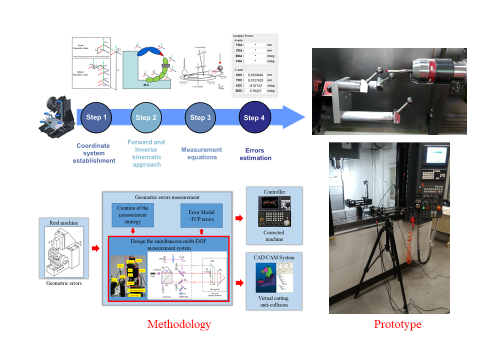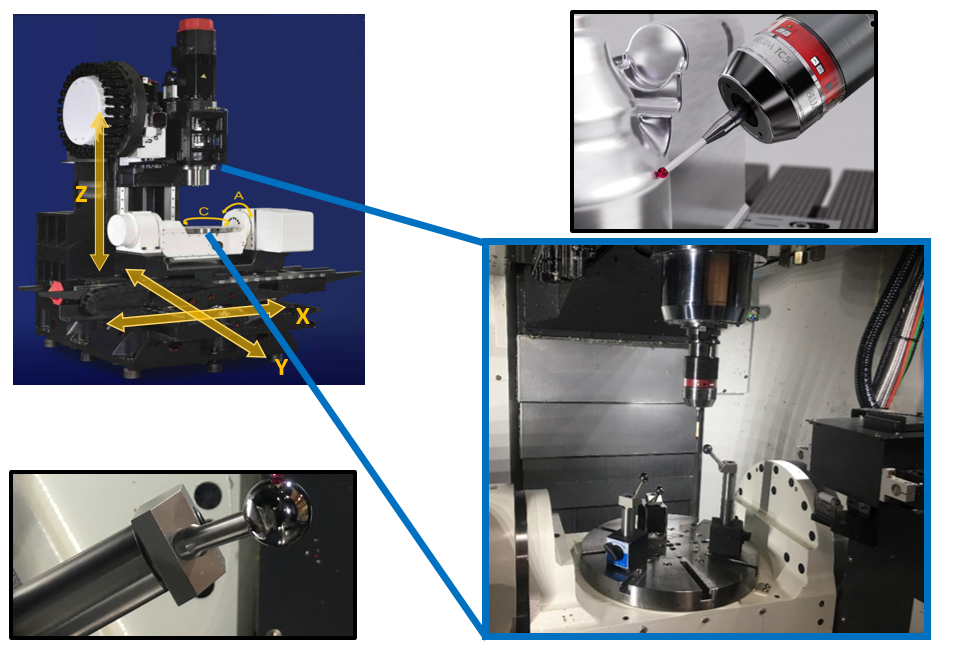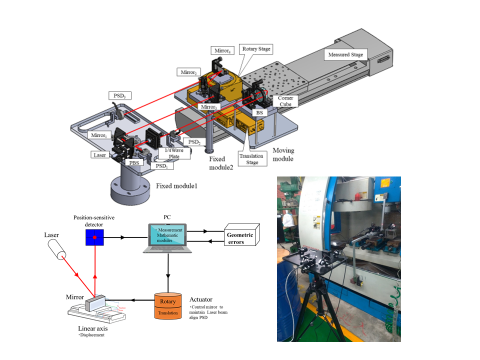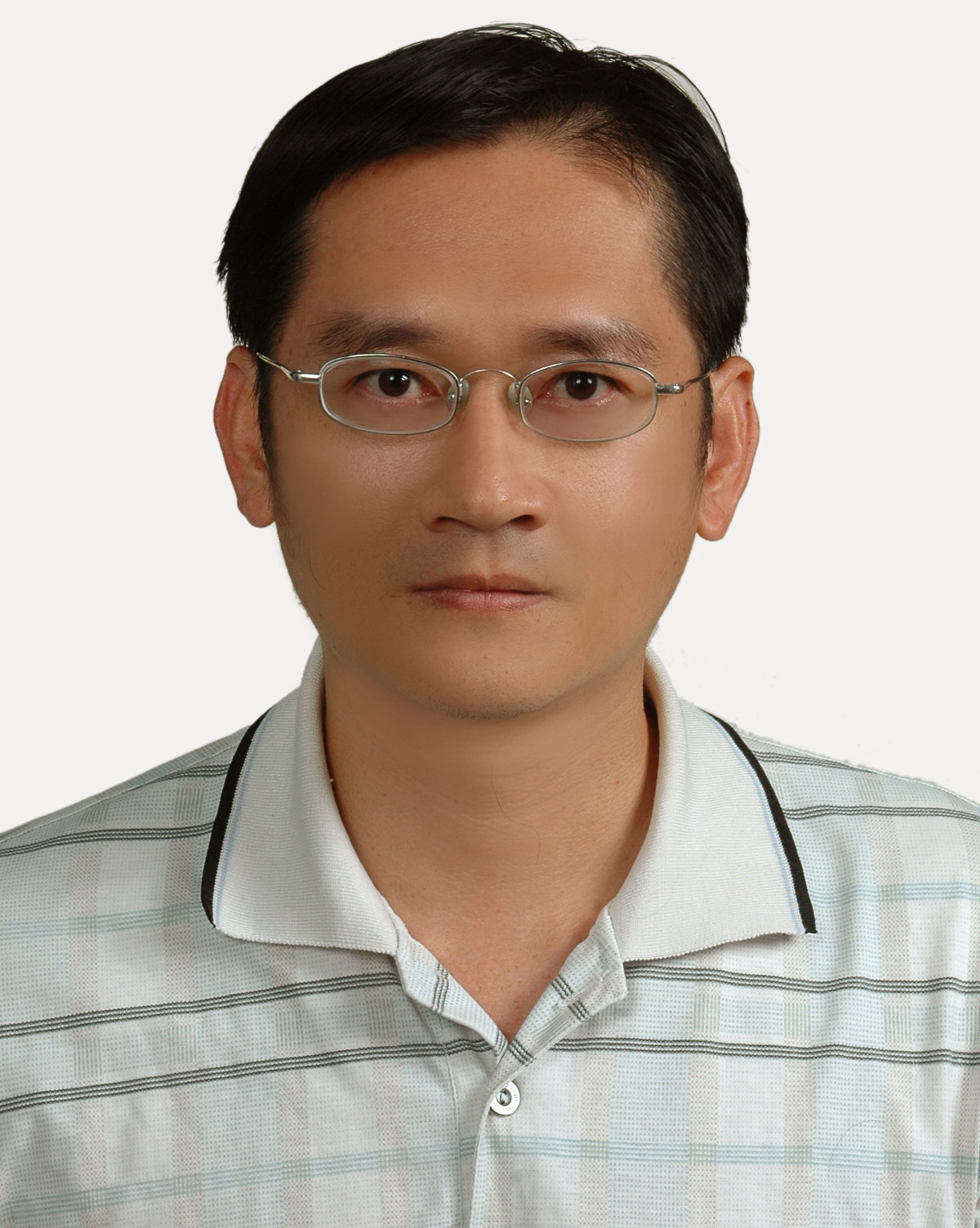Geometric error measurement and compensation technology of precise machinery
|
Geometric error measurement and compensation technology of precise machinery For intelligent manufacturing, the geometric errors of the precise mechanical linear displacement platform and the rotary platform have a huge impact on the machine positioning and machining accuracy. Therefore, over the past 10 years, Professor Liu’s research team has been committed to the design and development of a domestic independent precise mechanical geometric error measurement and compensation system, featuring customization, cost reduction and patented design, including contact and non-contact measurement systems. The key core capabilities of these measurement systems are spatial error analysis and error decoupling. The research team can use the developed measurement systems to combine with the practical application of the industry, conduct experiments and analysis on the problems of the manufacturer's machine, and can customize the design, which can provide the manufacturer with a set of effective detection method of machine geometric motion error. |
|||||||
| ______________________________________________________________________________________________________________________ | |||||||
|
For precision intelligent manufacturing and machinery industry, high-precision linear displacement platform and rotary platform play a very important role. In recent years, multi-axis machine tools have been widely used in manufacturing applications with complex geometry, high precision and high efficiency, in which the geometric errors of the linear displacement platform and the rotary platform have a huge impact on the machining accuracy. At present, ISO 230-2, ISO230-6 and ISO 230-7 and other relevant international standard inspection specifications have been formulated for the geometric errors of linear displacement platform and the rotary platform of the machine tools. For an ideal linear displacement platform or rotary platform, when the linear displacement platform or rotary platform is moved and positioned, it has only a single-degree-of-freedom geometric motion error; but in fact, when the linear displacement platform or rotary platform is actuated, six degree-of-freedom geometric motion errors will be generated at the same time. The six degree-of-freedom geometric motion errors will affect the geometric accuracy of the linear displacement platform or the rotary platform. At present, in industrial applications, laser interferometers, laser Dopplers, automatic collimators, Ball Bars and R-TESTs have been widely used to measure the geometric motion errors of linear displacement platforms or rotary platforms. Among them, the most representative measurement equipment is the laser interferometer, which has the advantages of high precision and reliability, but most laser interferometers can measure only a single geometric error per measurement with a given optical accessory; therefore, quantifying all errors is extraordinarily time intensive. If a large number of interferometers are used to build a measurement system, the system’s construction cost will also be greatly increased. And most other commercially available products also have this disadvantage. Looking at the literature review, most measurement systems are very expensive, and the measurement systems contain many optical components, which are very complicated and difficult to set up. In addition, commercially available products cannot meet the needs of customization. |
|||||||
|
Figure 1 Geometrical motion error measurement system for AC rotary stage of CNC five-axis machine tool. |
|||||||
|
Therefore, Professor Liu’s research team is committed to the design and development of a domestic independent precise mechanical geometric error measurement system, featuring customization, cost reduction and patented design, including contact and non-contact measurement systems. The developed touch measurement system uses commercially available touch-trigger probes and standard balls. The advantages are that the price is quite affordable and the accuracy is high. The touch-trigger itself is quite simple and fast to install. Figure 1 shows the geometrical motion error measurement system of the AC rotary platform of the five-axis CNC machine tool developed by the research team. The unique three-ball invention patent is used to measure the geometrical motion errors of the rotary platform. At present, 10 degree-of-freedom geometric motion errors of the rotary platform can be measured synchronously. The developed non-contact measurement system is based on the geometric optics method, and uses an innovative mechanism to realize the measurement of the positioning error of the long-stroke linear stage of the machine tool, and to measure the other 5 degree-of-freedom geometric motion errors at the same time, so as to improve the measurement accuracy and efficiency. Figure 2 shows the geometric motion error measurement system of the linear displacement platform of the CNC machine tool developed by this research team. At present, 6 degree-of-freedom geometric motion errors of the linear displacement platform can be measured synchronously.
|
|||||||
|
Figure 2 Geometrical motion error measurement system for linear displacement stage of CNC machine tool. |
|||||||
|
The research team can use the developed measurement systems to combine with the practical application in the industry, conduct experiments and analysis on the problems of the manufacturer's machine, and provide a set of effective methods for the manufacturer to detect the geometric motion errors of the machine. It is expected that it will be helpful to the development of the precision machinery industry in the future. |
|||||||
| ______________________________________________________________________________________________________________________ | |||||||
|
|||||||
subscribe E-news
Vol.34 NO.4(2022.8)-4 Author information
|
Author
Chien-Sheng Liu Department of Mechanical Engineering, National Cheng Kung University(NCKU) |
|
|
|
Research members Chien‑Sheng Liu1,Jie-Yu Zeng1,Tang-Chao Liu1,Wei‑Che Tai1,Ting‑Yu Lee1,Yu‑Ta Chen2 1Department of Mechanical Engineering, National Cheng Kung University, No. 1, University Road, Tainan City 70101, Taiwan 2Department of Mechanical Engineering, Southern Taiwan University of Science and Technology, No. 1, Nan‑Tai Street, Yungkang Dist., Tainan City 710301, Taiwan |
|
Key words Precision measurement, online inspection, geometric error, machine tool, error decoupling |
|
Research areas Prospective science & technology research |
|
References
1.Y. T. Chen, T. Y. Lee, and C. S. Liu*, “Synchronous measurement and verification of position-independent geometric errors and position-dependent geometric errors in c-axis on mill-turn machine tools,” International Journal of Advanced Manufacturing Technology, Online, 2022. https://link.springer.com/article/10.1007/s00170-022-09648-5 2.W. C. Tai and C. S. Liu*, “Development and verification of six-degree-of-freedom error measurement system based on geometrical optics for linear stage,” International Journal of Advanced Manufacturing Technology, vol. 119, pp. 3903–3916, 2022. https://link.springer.com/article/10.1007/s00170-022-08650-1 3.C. S. Liu*, J. Y. Zeng, and Y. T. Chen, “Development of positioning error measurement system based on geometric optics for long linear stage,” International Journal of Advanced Manufacturing Technology, vol. 115, pp. 2595–2606, 2021. https://link.springer.com/article/10.1007/s00170-021-07332-8 4.C. S. Liu*, J. J. Lai, and Y. T. Luo, “Design of a measurement system for six-degree-of-freedom geometric errors of a linear guide of a machine tool,” Sensors, vol. 19, pp. 5, 2019. |
|
Download
Geometric error measurement and compensation technology of precise machinery |










